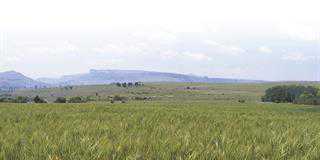Agricultural soils are among the planet’s largest reservoirs of carbon, explains Profert’s general manager, Ben Krog. By sequestering carbon, soil microorganisms reduce greenhouse gas levels in the atmosphere – this puts the power to minimise the impact of climate change in farmers’ hands.
Soil organisms perform a vast range of essential services in ecosystems’ functioning. They’re the primary driving agents of nutrient cycling, regulate the dynamics of soil organic matter, are essential for sequestering carbon, modify soil physical structure and water regimes, and enhance nutrient acquisition and plant health.
Ben says these services are critical for the sustainable management of agricultural systems. Agricultural soils sequester a significant amount of atmospheric carbon dioxide through the formation of soil organic matter. This is produced by the activity of soil microorganisms that decompose plant material. It can contribute as much as 20% to 30% of the reduction required to maintain atmospheric carbon dioxide levels, currently estimated at 360 parts per million.
A two-way street
Ben explains that soil fertility can be defined as the soil’s ability to support optimal plant growth. “Since different plants may require different growth conditions, there is no clear-cut concept of soil fertility,” he says. “It depends on environmental, physical and chemical factors related to plant nutrition. But with careless agricultural practices, the soil won’t be able to support sustainable agriculture and food security in the long term.”
Ben says soil organisms are vital for soil fertility and health in both natural and managed agriculture soils. “There is a two-way relationship between the soil organisms and agricultural production. Soil organisms play a key role in the number of key nutrient transformation processes, while crop residues are essential supplies of carbon, which acts as an energy source. They are also a source of nutrients for microbial activity.”
A varied population
The soil microbial system is very dynamic and sensitive. Many factors affect its composition, making it very difficult to predict its characteristics under all circumstances. There are more living organisms in the soil than all other ecosystems combined. They range in size from microscopic, such as bacteria of 2 microns (2 000ths of a millimetre) to earthworms. Added together, these microfauna and -flora can easily weigh up to 1 200kg/ha. Their activities are concentrated in the top 200mm of the top soil.
Soil organisms can also be classified by their carbon and oxygen requirements: Autotrophs (meaning “self-feeding”) usually use the sun to manufacture their own energy, and obtain carbon from atmospheric carbon dioxide. Other autotrophs produce energy through the oxidation of certain inorganic substances, such as sulphur, iron and ammonium. Autotrophs include plants, algae and some bacteria.
Heterotrophs, in contrast, obtain their energy and carbon from the breakdown of organic materials such as humus, plant debris and other organisms. Examples include bacteria, fungi, protozoa and soil animals. Aerobes are organisms requiring atmospheric oxygen for respiration. They’re associated with soils that have good drainage and aeration.
Anaerobes do not need free oxygen, but depend on various compounds such as nitrate and sulphate. Facultative anaerobes are adaptable and can survive with or without free oxygen. Anaerobes are generally associated with waterlogged conditions.
Making humus
Most soil organisms are beneficial saprophytes, consuming dead organic matter and posing no threat to living plants. Their primary benefit is the decomposition of carbon-containing organic matter, containing various chemical compounds that play different roles in the ecosystem, break down at different rates, and give each soil type its own unique character. The most important compounds that make up the bulk of the material are cellulose, lignin, chitin, lipids, protein and simple soluble molecules.
Trapping carbon in agricultural soils |
Carbon can be sequestered in soils by:
|
Ben explains, “As organic matter breaks down, it forms the most important part of humus, which accumulates in the soil and is relatively resistant to microbial breakdown. One of humus’s major components is residual lignin, which oxidises to give humus its black colour. The phenolic groups also contribute to humus’s characteristic smell.
“Humus decays slowly through oxidation in hot dry climates and through microbial breakdown in warm, wet ones. A flux usually occurs after a dry spell, due to oxidation. Humus loses carbon in the form of carbon dioxide, and the composition of its resistant compounds is altered. Afterwards, when climatic conditions become favourable and the soil is moistened, the digestible compounds increase and the population of soil organisms explodes.”
The role of fertiliser
Fertilisers are effective in ecologically sound farming production systems, when used as part of an integrated plant nutrient management programme. Their responsible use contributes to farming efficiency and water conservation, argues Ben.
“Mineral fertilisation with macro- and micronutrients balances nutrients and optimises soil productivity, producing a healthy, vigorous crop,” he says. Fertilisers help crops fix carbon dioxide through photosynthesis. Directly increasing biomass also means more food for microorganisms.
However, because of fertiliser’s chemical properties, mismanaging its use can also harm soil microorganisms, Ben cautions. “Virtually all fertiliser materials are salts. When they dissolve, they increase the salt concentration in the soil, increasing the osmotic potential of the soil solution. A high osmotic potential makes it difficult for organisms, including seedlings and roots, to extract soil water” (see box: The salt index reference).
|
The Salt Index reference is a method to compare fertiliser sources and shows which is most likely to cause injury. The base reference point for the Salt Index is that of sodium nitrate, which is 100. Other examples are the Salt Index values for:
KCl, for example, placed in a band with a planter, will have a more detrimental salt impact than a fertiliser like DAP. |
“All compound or bulk blended fertilisers that contain nitrogen will undergo an acidification process due to a chemical and/or biological reaction in the soil,” Ben warns. The pH in the soil solution directly around the particle will drop, harming the microbe population, especially acid-sensitive bacteria. The efficiency of applied fertilisers is usually low due to leaching, volatilisation and fixation – as low as 40% to 60% for nitrogen, 40% to 50% for potassium, and 30% for phosphorus.
Arguably, the most limiting factor in plant nutrition a decade ago was phosphate or nitrogen. Today, it’s microbial activity. “Soil microorganisms will increase the efficiency of applied fertilisers,” Ben advises. “Plant nutritionists today need a holistic approach towards plant nutrition and soil biology.”
Contact Ben Krog at [email protected].













